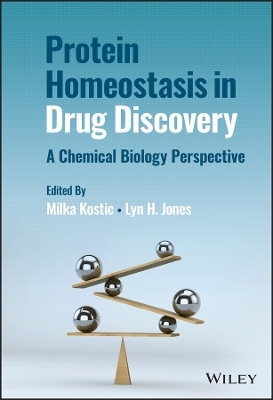
Protein Homeostasis in Drug Discovery
John Wiley & Sons Inc (Verlag)
978-1-119-77412-9 (ISBN)
- Lieferbar
- Versandkostenfrei
- Auch auf Rechnung
- Artikel merken
Protein Homeostasis in Drug Discovery highlights drug discovery and development efforts targeting protein homeostasis and considers the emerging appreciation that a protein’s activity may not be the only factor to consider when developing therapeutic agents.
The chapters cover various aspects of protein homeostasis such as cellular localization, abundance, interactions, and more. Moreover, the text contains up-to-date information regarding targeted protein degradation, an emerging drug discovery modality.
Readers interested in targeting different regulatory events that control protein homeostasis or modulating protein abundance will find this book an excellent resource. Furthermore, those interested in the link between biological function and regulating protein levels in living organisms, especially in the context of drug discovery, will learn from numerous examples discussed in this book.
In Protein Homeostasis in Drug Discovery, readers can expect to find information on:
Protein folding, quality control, pharmacology, and drug targeting processes
Recent advances in our understanding of protein homeostasis, covering emerging technologies and opportunities for therapeutic intervention
Targeted protein degradation (TPD) and strategies such as PROTACs and molecular glues, including a chapter on TPD as an antiviral drug discovery strategy
Drug discovery and development efforts aimed at correcting, stabilizing, and rescuing proteins, with examples included
Advantages and key shortcomings of both phenotypic and target-based traditional drug discovery methods
Collectively, Protein Homeostasis in Drug Discovery offers the reader an opportunity to learn more about the importance of considering and targeting protein homeostasis. The text is a must-read resource for academics, professionals in the pharmaceutical industry, and advanced students in various science-related fields.
Milka Kostic, PhD, is the Program Director for Chemical Biology at the Dana-Farber Cancer Institute and her interests include advocating for the importance of chemical biology as a critical link in the chemistry-biology-medicine continuum. Lyn H. Jones, PhD, is currently Director of the Center for Protein Degradation at the Dana-Farber Cancer Institute and his interests include using chemogenomics and chemoproteomics to advance new therapeutic modalities.
List of Contributors ix
Preface xv
Section I Protein Folding and Quality Control in Drug Discovery 1
1 Epichaperomes as a Gateway to Understanding, Diagnosing, and Treating Disease Through Rebalancing Protein–Protein Interaction Networks 3
Chander S. Digwal, Sahil Sharma, Anand R. Santhaseela, Stephen D. Ginsberg, and Gabriela Chiosis
2 Stability of Steroid Hormone Receptors: The Intersection of Proteostasis and Selective Degradation 27
Zachary J. Gale-Day and Jason E. Gestwicki
3 Pharmacological Chaperones: Therapeutic Potential for Diseases Resulting from GPCR Misfolding 65
Suli-Anne Laurin, Sajjad Ahrari, and Michel Bouvier
Section II Protein Degradation and Clearance as Drug Targeting Opportunities 135
4 Exploiting the Proteasome for Disease Treatment: From Dynamic Architecture to Vast Functions 137
Gwen R. Buel, Xiuxiu Lu, and Kylie J. Walters
5 Targeting the Ubiquitination Cascade for Drug Discovery 179
Qi Liu, Gabriel LaPlante, and Wei Zhang
6 Understanding, Targeting, and Hijacking Autophagy 227
Hongguang Xia, Xiaoyan Xu, Mengxin Zhou, Manke Zhang, and Lingzhi Ye
7 Deubiquitinating Enzymes: From Undruggable Targets to Emerging Opportunities 249
Xiaoxi Liu, Laura Doherty, Alejandra Felix, and Sara Buhrlage
Section III Redirecting Protein Degradation Processes for Drug Development 283
8 History of IMiDs and Protein Degradation as a Pharmacological Modality 285
Junichi Yamamoto, Tomoko Asatsuma-Okumura, Takumi Ito, Yuki Yamaguchi, and Hiroshi Handa
9 PROTAC Degraders: Mechanism, Recent Advances, and Future Challenges 317
Alessio Ciulli and Oliver Hsia
10 Biochemical Principles of Targeted Protein Degradation 357
Roman V. Agafonov, Richard W. Deibler, William A. Elam, Joe S. Patel, and Stewart L. Fisher
11 Pharmacology of PROTAC Degrader Molecules: Optimizing for In Vivo Performance 385
Andy Pike, Sofia Guzzetti, Pablo M. Morentin Gutierrez, and James S. Scott
Section IV Emerging Technologies and Future Opportunities 419
12 Proximity-Inducing Bifunctional Molecules Beyond PROTACs 421
Sophia Lai, Ashley E. Modell, and Amit Choudhary
13 Strategies for Tag-Based Protein Control 447
Behnam Nabet, Nathanael S. Gray, and Fleur M. Ferguson
14 Targeted Protein Degradation in Antiviral Drug Discovery 465
Mélissanne de Wispelaere and Priscilla L. Yang
15 Beyond Inhibition: Ligand-Based Pharmacological Exploration as a Strategy Toward New Targets and Modalities 491
Milka Kostic and Lyn H. Jones
Index 519
| Erscheinungsdatum | 21.11.2022 |
|---|---|
| Verlagsort | New York |
| Sprache | englisch |
| Gewicht | 1007 g |
| Themenwelt | Naturwissenschaften ► Biologie |
| Naturwissenschaften ► Chemie ► Organische Chemie | |
| ISBN-10 | 1-119-77412-8 / 1119774128 |
| ISBN-13 | 978-1-119-77412-9 / 9781119774129 |
| Zustand | Neuware |
| Informationen gemäß Produktsicherheitsverordnung (GPSR) | |
| Haben Sie eine Frage zum Produkt? |
aus dem Bereich


